Sweden qualified for their first FIFA World Cup since 2006 by finishing second in a tough group behind France but ahead of the Netherlands. They then managed to knock Italy out of the play-offs with a 1-0 aggregate score. In this team profile, we’ll look at their coach Janne Andersson, their squad, tactics, key man, young player to watch and a wildcard ahead of Russia 2018.
Sweden’s squad
Coach
Janne Andersson
Andersson has a long and quite up-and-down career in Swedish football. He had his first coaching job back in 1988 but has since 2004 been a regular around the Swedish top flight. He finished second in 2004 with home-town club Halmstads BK before finally winning Allsvenskan in 2015 with IFK Norrköping. When Sweden coach Erik Hamrén stepped down after the 2016 Euro’s Andersson was appointed as national team coach. His work so far has been impressive, securing a win against France in qualifying and steering Sweden to the play-offs ahead of the Netherlands.
When there, Sweden faced Italy and managed to go through after two extremely defensive performances stopped the Italians scoring. The only goal of the two-legged tie came in Stockholm when Jakob Johansson’s deflected strike gave Sweden the win. Andersson has built a very strong defensive side who head to Russia and the FIFA World Cup with great confidence.
Goalkeepers
Robin Olsen, Karl-Johan Johnsson, Kristoffer Nordfeldt
Defenders
Mikael Lustig, Emil Krafth, Andreas Granqvist, Victor Nilsson-Lindelöf, Pontus Jansson, Filip Helander, Ludwig Augustinsson, Martin Olsson
Midfielders
Emil Forsberg, Jimmy Durmaz, Sebastian Larsson, Albin Ekdal, Viktor Claesson, Gustav Svensson, Oscar Hiljemark, Marcus Rohdén
Forwards
Marcus Berg, Ola Toivonen, John Guidetti, Isaac Kiese Thelin
Andersson’s tactics
Sweden under Janne Andersson is a very defensive side. The focus defensively is to maintain a compact 4-4-2 shape at all times and force the opponent into wide areas. The orientation is strictly positional, the team moves up, down and to the sides as a unit depending on the position of the ball and in reference to their teammates. Sweden do this brilliantly. They will probably the best defensively organized side in Russia and each player perfectly understands their roles. Below you see just how compact they are.
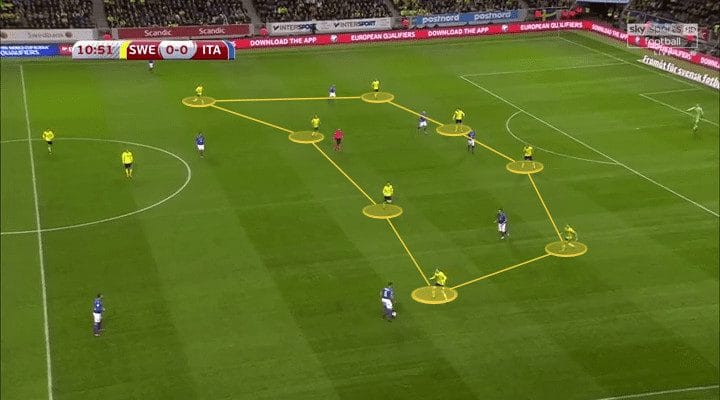
Here’s another example of the compactness of the Swedish side defensively.
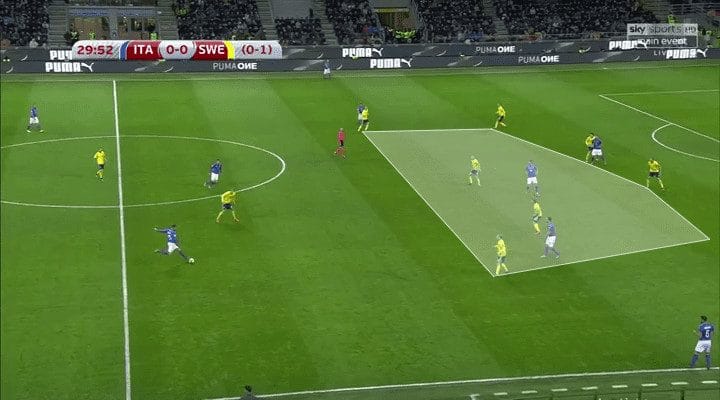
When possession is won, Sweden are mostly very direct. They look for the physical front-two of Ola Toivonen and Marcus Berg with long-high balls and then fight for flick-ons or second balls. This isn’t the most cultured approach you’ll see in Russia but they could cause some problems against the defences of Mexico, South Korea and even Germany with this style of play.
Sweden aren’t only long-balls though. They have some interesting ideas in possession when they try to build attacks from the back. The key is the movement of left midfielder Emil Forsberg. Forsberg frequently moves inside with the left-back Augustinsson pushing on down the flank. The right-back Mikael Lustig plays a more reserved role and stays back to create a back-three with the centre-backs. Whoever plays as the right midfielder is therefore forced to maintain on the right. This creates a situational 3-5-2 in possession as illustrated below.
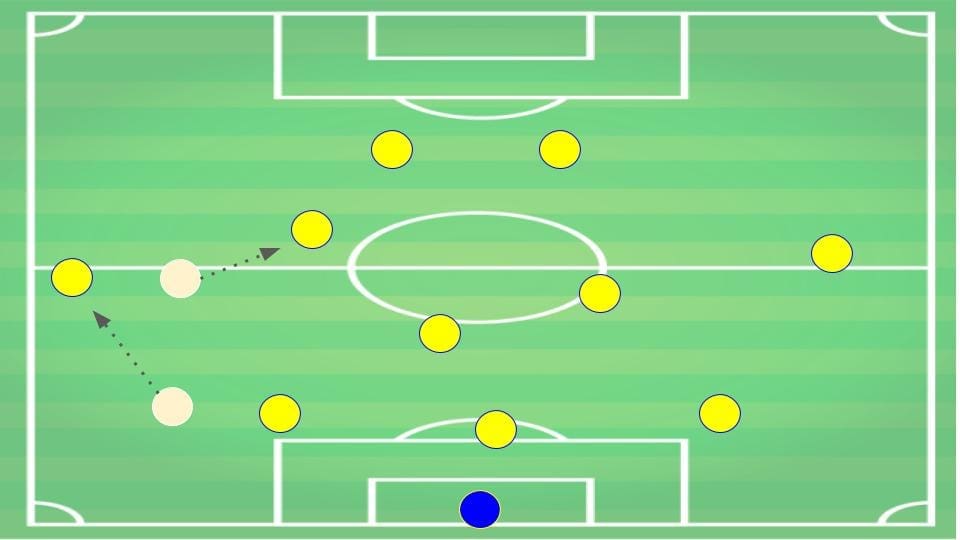
Below we see an example of how Sweden start their build-up. Victor Lindelöf is often used as the central centre-back in possession due to his superior passing ability over Granqvist. Albin Ekdal is the midfielder who most often come deep to get on the ball and look to progress the play forward.
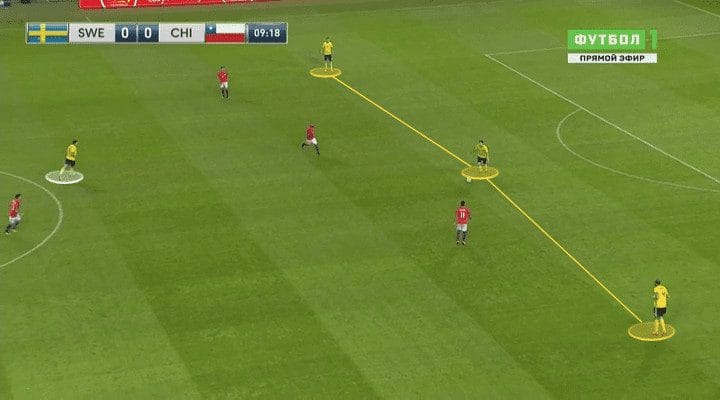
And below is an example of what it looks like further up the field. Forsberg (white) has moved inside with left-back Martin Olsson (yellow) pushing forward on the wing.
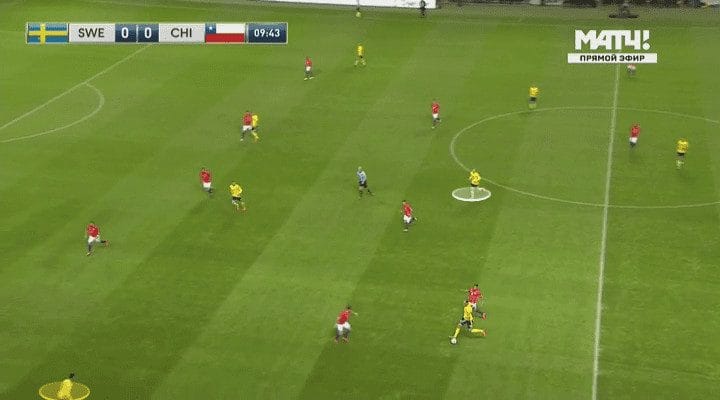
Make no mistake about it, at their best this Swedish side can definitely play. However, with the opponents being Germany and Mexico who are far superior on the ball than the Swedes, we are more likely to see a very direct Swedish side. They will be horrible to play against, especially the front-two who aren’t afraid to use elbows to get their way.
Probable starting team (4-4-2)
Olsen
Lustig-Lindelöf-Granqvist-Augustinsson
Claesson-Larsson-Ekdal-Forsberg
Berg-Toivonen
Key man
Andreas Granqvist
The centre-back will feel at home in Russia after spending several seasons at Krasnodar. After two solid defensive displays against Italy, Granqvist was given the “Guldbollen” award as the Swedish footballer of 2017. He thus became the first player not named Zlatan Ibrahimovic to win the award for over a decade. Him getting the award was definitely heavily influenced by a euphoric Swedish public labelling “Granen” a cult hero and a legend for helping shut out the Italians.
Still, Granqvist is the Swedish captain and extremely important for the team. He is a big reason why Victor Nilsson-Lindelöf looks so more composed playing for Sweden than for Manchester United. His experience will be vital in Russia. Granqvist is a strong defender who reads the game well and defends the penalty area as is his life depended on it. Against attacking sides like Germany and Mexico in the group stage, Granqvist will need to be at his best and show that he can live up to the hype his performances in qualifying has created.
Young player to watch
Ludwig Augustinsson
The 24-year-old left-back has been a mainstay in the Swedish setup after impressing when Sweden won the U21 Euros in 2015. Regularly linked with bigger clubs when at FC Copenhagen, Augustinsson made the sensible decision to move to Werder Bremen in the Bundesliga to further his development. Having made 29 starts in Germany this season, it’s safe to say he has established himself in the German top flight. A strong World Cup could mean one of those big clubs come circling again.
Augustinsson is a very intelligent defender who excels in the attacking phase. With Forsberg ahead of him often making inverted movements it’s often up to Augustinsson to maintain width on the left. He does this well and can deliver threatening crosses into the box for the physical strike duo Sweden will deploy. He can still improve defensively with his positioning sometimes not up to the levels of the rest of his game. Though, in the well-organized defensive unit Sweden is, these flaws won’t be too visible in Russia. Augustinsson is definitely a player to watch for Sweden.
Wildcard
Emil Forsberg
In a squad which definitely lacks creativity and improvisation in the final third, Emil Forsberg will be absolutely vital. The RB Leipzig attacker will play on the left of Sweden’s midfield in a quite free role in an otherwise quite rigid setup. Forsberg beat the Bundesliga record for assists last season with 19 assists to go with his eight goals. He’s had a tougher season this campaign, only starting 15 games in the league, scoring twice and making as many assists.
Sweden will desperately need him to hit top form to inject a little unpredictability to an otherwise very predictable attack. Forsberg will likely get the freedom to come inside from the flank and look for spaces behind the opponent’s midfield line with Augustinsson attacking down the wing. If he finds his form and delivers then Sweden will have a good chance of progressing from the group.
Summary
Sweden are looking forward to a first World Cup in 12 years. They will definitely be a tough team to face in Russia. Italy struggled against them. France and the Netherlands did too. Sweden can probably surprise a few people. They need Forsberg in top form to do so however since the squad desperately lacks creativity and pace from other players. It’s a very functional and hard-working squad, but they might lack the quality needed to go through. Just being there is a testament to the strength of this team. It will be interesting to see what they can go on to achieve.





Comments